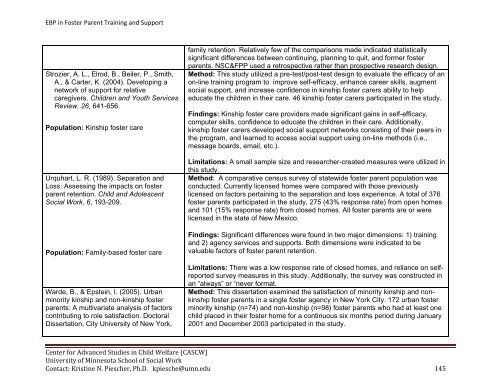Evidence-Based Practice in Foster Parent Training and Support ...
Evidence-Based Practice in Foster Parent Training and Support ...
Evidence-Based Practice in Foster Parent Training and Support ...
Create successful ePaper yourself
Turn your PDF publications into a flip-book with our unique Google optimized e-Paper software.
EBP <strong>in</strong> <strong>Foster</strong> <strong>Parent</strong> Tra<strong>in</strong><strong>in</strong>g <strong>and</strong> <strong>Support</strong>Strozier, A. L., Elrod, B., Beiler, P., Smith,A., & Carter, K. (2004). Develop<strong>in</strong>g anetwork of support for relativecaregivers. Children <strong>and</strong> Youth ServicesReview, 26, 641-656.Population: K<strong>in</strong>ship foster careUrquhart, L. R. (1989). Separation <strong>and</strong>Loss: Assess<strong>in</strong>g the impacts on fosterparent retention. Child <strong>and</strong> AdolescentSocial Work, 6, 193-209.Population: Family-based foster careWarde, B., & Epste<strong>in</strong>, I. (2005). Urbanm<strong>in</strong>ority k<strong>in</strong>ship <strong>and</strong> non-k<strong>in</strong>ship fosterparents: A multivariate analysis of factorscontribut<strong>in</strong>g to role satisfaction. DoctoralDissertation, City University of New York,family retention. Relatively few of the comparisons made <strong>in</strong>dicated statisticallysignificant differences between cont<strong>in</strong>u<strong>in</strong>g, plann<strong>in</strong>g to quit, <strong>and</strong> former fosterparents. NSC&FPP used a retrospective rather than prospective research design.Method: This study utilized a pre-test/post-test design to evaluate the efficacy of anon-l<strong>in</strong>e tra<strong>in</strong><strong>in</strong>g program to improve self-efficacy, enhance career skills, augmentsocial support, <strong>and</strong> <strong>in</strong>crease confidence <strong>in</strong> k<strong>in</strong>ship foster carers ability to helpeducate the children <strong>in</strong> their care. 46 k<strong>in</strong>ship foster carers participated <strong>in</strong> the study.F<strong>in</strong>d<strong>in</strong>gs: K<strong>in</strong>ship foster care providers made significant ga<strong>in</strong>s <strong>in</strong> self-efficacy,computer skills, confidence to educate the children <strong>in</strong> their care. Additionally,k<strong>in</strong>ship foster carers developed social support networks consist<strong>in</strong>g of their peers <strong>in</strong>the program, <strong>and</strong> learned to access social support us<strong>in</strong>g on-l<strong>in</strong>e methods (i.e.,message boards, email, etc.).Limitations: A small sample size <strong>and</strong> researcher-created measures were utilized <strong>in</strong>this study.Method: A comparative census survey of statewide foster parent population wasconducted. Currently licensed homes were compared with those previouslylicensed on factors perta<strong>in</strong><strong>in</strong>g to the separation <strong>and</strong> loss experience. A total of 376foster parents participated <strong>in</strong> the study, 275 (43% response rate) from open homes<strong>and</strong> 101 (15% response rate) from closed homes. All foster parents are or werelicensed <strong>in</strong> the state of New Mexico.F<strong>in</strong>d<strong>in</strong>gs: Significant differences were found <strong>in</strong> two major dimensions: 1) tra<strong>in</strong><strong>in</strong>g<strong>and</strong> 2) agency services <strong>and</strong> supports. Both dimensions were <strong>in</strong>dicated to bevaluable factors of foster parent retention.Limitations: There was a low response rate of closed homes, <strong>and</strong> reliance on selfreportedsurvey measures <strong>in</strong> this study. Additionally, the survey was constructed <strong>in</strong>an “always” or “never format.Method: This dissertation exam<strong>in</strong>ed the satisfaction of m<strong>in</strong>ority k<strong>in</strong>ship <strong>and</strong> nonk<strong>in</strong>shipfoster parents <strong>in</strong> a s<strong>in</strong>gle foster agency <strong>in</strong> New York City. 172 urban fosterm<strong>in</strong>ority k<strong>in</strong>ship (n=74) <strong>and</strong> non-k<strong>in</strong>ship (n=98) foster parents who had at least onechild placed <strong>in</strong> their foster home for a cont<strong>in</strong>uous six months period dur<strong>in</strong>g January2001 <strong>and</strong> December 2003 participated <strong>in</strong> the study.Center for Advanced Studies <strong>in</strong> Child Welfare (CASCW)University of M<strong>in</strong>nesota School of Social WorkContact: Krist<strong>in</strong>e N. Piescher, Ph.D. kpiesche@umn.edu 145
















